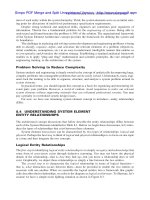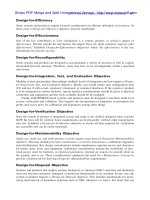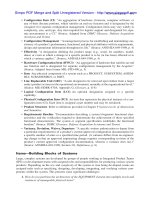tpm principles and concepts
Bạn đang xem bản rút gọn của tài liệu. Xem và tải ngay bản đầy đủ của tài liệu tại đây (697.86 KB, 66 trang )
Total Productive Maintenance
(TPM)
SMJ 4812 Project Management &
Maintenance Engrg.
Semester I 2003/2004
1
Introduction to TPM
What is TPM ?
Total Productive Maintenance (TPM) is both
– a philosophy to permeate throughout an
operating company touching people of all
levels
– a collection of techniques and
practices
aimed at maximizing the effectiveness (best
possible return) of business facilities and
processes
2
3
It is a Japanese approach for
• Creating company culture for maximum
efficiency
• Striving to prevent losses with minimum
cost
– Zero breakdowns and failures, Zero accident,
and Zero defects etc
• The essence of team work (small group
activity) focused on condition and performance of
facilities to achieve zero loss for improvement
• Involvement of all people from top
management to operator
4
History/Origin
• TPM first introduced in Japan 20 years ago
and rigorously been applied in past 10 years
• TPM planning & implementation in Japanese
factories supported by JIPM (Japan Institute
of Plant Maintenance)
• Awarded yearly prizes to various industries:
Automotive
Metals
Chemicals
Rubber
Food
Glass etc.
5
• Initially implemented in
high-to-medium volume production areas
• Later successfully applied in:
Low-volume production
High-to-low volume assembly
Development areas
Warehouse
Whole range of industry
6
Role of TPM
Answers of the following questions are able
to tell what role TPM can play within a
company:
Does TPM replace traditional maintenance
techniques ?
Why is it so popular and important ?
What are its policies and objectives ?
How does it fit in with TQM ?
What are its steps, activities and
components?
What are its benefits and results ?
7
TPM and Traditional Maintenance
Reactive maintenance inherently wasteful
and ineffective with following
disadvantages:
•
•
•
•
•
No warning of failure
Possible safety risk
Unscheduled downtime of machinery
Production loss or delay
Possible secondary damage
8
Need for:
•
•
•
Stand-by machinery
A stand-by maintenance team
A stock of spare parts
Costs include:
•
•
•
•
•
Post production
Disrupted schedule
Repair cost
Stand-by machinery
Spare parts
9
Real cost of reactive maintenance is
more than the cost of maintenance
resources and spare parts
Pro-active maintenance (planned,
preventive and predictive) more
desirable than reactive maintenance
10
TPM enables or provides:
•
•
•
The traditional maintenance practices
to change from reactive to pro-active
A number of mechanisms whereby
Breakdowns are analyzed
Causes investigated
Actions taken to prevent further
breakdowns
Preventive maintenance schedule to
be made more meaningful
11
•
•
To ‘free up’ maintenance professionals to:
Carry out scheduled and preventive
maintenance
Gather relevant information as important
input to the maintenance system
Keep the system up to date
To review cost effectiveness
To develop and operate a very effective
maintenance system an integral part of
manufacturing
12
Why is TPM so popular and important ?
Three main reasons:
1. It guarantees dramatic results
(Significant tangible results)
• Reduce equipment breakdowns
• Minimize idle time and minor stops
• Less quality defects and claims
• Increase productivity
• Reduce manpower and cost
• Lower inventory
• Reduce accidents
13
2. Visibly transform the workplace
(plant environment)
•
•
•
Through TPM, a filthy, rusty plant covered in
oil and grease, leaking fluids and spilt
powders can be reborn as a pleasant and
safe working environment
Customers and other visitors are impressed
by the change
Confidence on plant’s product increases
14
3. Raises the level of workers knowledge
and skills
As TPM activities begin to yield above
concrete results, it helps:
• The workers to become motivated
• Involvement increases
• Improvement suggestions proliferate
• People begin to think of TPM as part of the
job
15
TPM Policy and Objectives
Policy and objectives:
• To maximize overall equipment
effectiveness (Zero breakdowns and
failures, Zero accident, and Zero defects
etc) through total employee involvement
• To improve equipment reliability
and maintainability as contributors to
quality and to raise productivity
16
TPM Basic policy and objectives
(Contd.)
•
To aim for maximum economy in
equipment for its entire life
•
To cultivate equipment-related expertise
and skills among operators
•
To create a vigorous and enthusiastic
work environment
17
TPM Corporate policy for the following
purposes:
•
To aim for world-class maintenance,
manufacturing performance and quality
•
To plan for corporate growth through
business leadership
18
TPM Corporate policy (Contd.):
•
To promote greater efficiency through
greater flexibility
•
Revitalize the workshop and make the
most of employee talents
19
Production dept.TPM to Companywide
TPM
20
12 TPM Development Program
Steps
Preparation
1. Formally announce the decision to introduce
TPM
2. Conduct TPM introductory education and
publicity campaign
3. Create TPM promotion organization
21
Preparation (Contd.)
4. Establish basic TPM policy and goals
5. Draft a master plan for implementing
TPM
Introduction
6. Kick off TPM initiatives
(to cultivate the atmosphere to raise morale,
inspiration and dedication)
22
Implementation
7. Build a corporate constitution
designed to maximize the effectiveness
of facilities
i. Conduct focused improvement activities
ii. Establish and deploy autonomous
maintenance program
iii. Implement planned maintenance program
iv. Conduct operation and maintenance skills
training
8. Build an early management system for
new products and equipment
23
Implementation (Contd.)
9.
Build a quality maintenance system
10. Build an effective administration and
support system
11. Develop a system for managing health,
safety, and the environment
Consolidation
12. Sustain a full TPM implementation and
raise levels (Prize)
24
Five fundamental TPM activities
1.
2.
3.
4.
Autonomous maintenance
Equipment improvement
Quality maintenance
MP(Maintenance Prevention) systembuilding
5. Education and training
25









